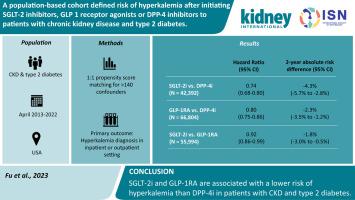当前位置:
X-MOL 学术
›
Kidney Int.
›
论文详情
Our official English website, www.x-mol.net, welcomes your
feedback! (Note: you will need to create a separate account there.)
A population-based cohort defined risk of hyperkalemia after initiating SGLT-2 inhibitors, GLP1 receptor agonists or DPP-4 inhibitors to patients with chronic kidney disease and type 2 diabetes
Kidney International ( IF 14.8 ) Pub Date : 2023-12-13 , DOI: 10.1016/j.kint.2023.11.025 Edouard L Fu 1 , Julianna Mastrorilli 1 , Katsiaryna Bykov 1 , Deborah J Wexler 2 , Alexander Cervone 1 , Kueiyu Joshua Lin 3 , Elisabetta Patorno 1 , Julie M Paik 4
Kidney International ( IF 14.8 ) Pub Date : 2023-12-13 , DOI: 10.1016/j.kint.2023.11.025 Edouard L Fu 1 , Julianna Mastrorilli 1 , Katsiaryna Bykov 1 , Deborah J Wexler 2 , Alexander Cervone 1 , Kueiyu Joshua Lin 3 , Elisabetta Patorno 1 , Julie M Paik 4
Affiliation

|
Hyperkalemia is a common adverse event in patients with chronic kidney disease (CKD) and type 2 diabetes and limits the use of guideline-recommended therapies such as renin-angiotensin system inhibitors. Here, we evaluated the comparative effects of sodium-glucose cotransporter-2 inhibitors (SGLT-2i), glucagon-like peptide-1 receptor agonists (GLP-1RA) and dipeptidyl peptidase-4 inhibitors (DPP-4i) on the risk of hyperkalemia. We conducted a population-based active-comparator, new-user cohort study using claims data from Medicare and two large United States commercial insurance databases (April 2013-April 2022). People with CKD stages 3-4 and type 2 diabetes who newly initiated SGLT-2i vs. DPP-4i (141671 patients), GLP-1RA vs. DPP-4i (159545 patients) and SGLT-2i vs. GLP-1RA (93033 patients) were included. The primary outcome was hyperkalemia diagnosed in inpatient or outpatient settings. Secondary outcomes included hyperkalemia diagnosed in inpatient or emergency department setting, and serum potassium levels of 5.5 mmol/L or more. Pooled hazard ratios and rate differences were estimated after propensity score matching to adjust for over 140 potential confounders. Initiation of SGLT-2i was associated with a lower risk of hyperkalemia compared with DPP-4i (hazard ratio 0.74; 95% confidence interval 0.68-0.80) and contrasted to GLP-1RA (0.92; 0.86-0.99). Compared with DPP-4i, GLP-1RA were also associated with a lower risk of hyperkalemia (0.80; 0.75-0.86). Corresponding absolute rate differences/1000 person-years were -24.8 (95% confidence interval -31.8 to -17.7), -5.0 (-10.9 to 0.8), and -17.7 (-23.4 to -12.1), respectively. Similar findings were observed for the secondary outcomes, among subgroups, and across single agents within the SGLT-2i and GLP-1RA classes. Thus, SGLT-2i and GLP-1RA are associated with a lower risk of hyperkalemia than DPP-4i in patients with CKD and type 2 diabetes, further supporting the use of these drugs in this population.
中文翻译:

基于人群的队列确定了慢性肾病和 2 型糖尿病患者开始使用 SGLT-2 抑制剂、GLP1 受体激动剂或 DPP-4 抑制剂后出现高钾血症的风险
高钾血症是慢性肾病 (CKD) 和 2 型糖尿病患者的常见不良事件,限制了指南推荐疗法(如肾素血管紧张素系统抑制剂)的使用。在此,我们评估了钠-葡萄糖协同转运蛋白 2 抑制剂 (SGLT-2i)、胰高血糖素样肽 1 受体激动剂 (GLP-1RA) 和二肽基肽酶 4 抑制剂 (DPP-4i) 对高钾血症风险的比较影响。我们使用 Medicare 和两个大型美国商业保险数据库(2013 年 4 月至 2022 年 4 月)的索赔数据进行了一项基于人群的主动比较新用户队列研究。新开始 SGLT-2i 与 DPP-4i(141671 名患者)、GLP-1RA 与 DPP-4i(159545 名患者)和 SGLT-2i 与 GLP-1RA(93033 名患者)的 CKD 3-4 期和 2 型糖尿病患者患者)也包括在内。主要结局是在住院或门诊环境中诊断出的高钾血症。次要结局包括在住院或急诊室诊断出的高钾血症,以及血清钾水平为 5.5 mmol/L 或更高。倾向评分匹配后估计汇总风险比和率差异,以调整 140 多个潜在混杂因素。与 DPP-4i 相比(风险比 0.74;95% 置信区间 0.68-0.80),并且与 GLP-1RA 相比(0.92;0.86-0.99),启动 SGLT-2i 与较低的高钾血症风险相关。与 DPP-4i 相比,GLP-1RA 还与较低的高钾血症风险相关(0.80;0.75-0.86)。相应的绝对率差异/1000人年分别为-24.8(95%置信区间-31.8至-17.7)、-5.0(-10.9至0.8)和-17.7(-23.4至-12.1)。在次要结果、亚组之间以及 SGLT-2i 和 GLP-1RA 类别内的单一药物之间也观察到了类似的结果。 因此,在 CKD 和 2 型糖尿病患者中,SGLT-2i 和 GLP-1RA 与高钾血症风险低于 DPP-4i 相关,这进一步支持了这些药物在该人群中的使用。
更新日期:2023-12-13
中文翻译:

基于人群的队列确定了慢性肾病和 2 型糖尿病患者开始使用 SGLT-2 抑制剂、GLP1 受体激动剂或 DPP-4 抑制剂后出现高钾血症的风险
高钾血症是慢性肾病 (CKD) 和 2 型糖尿病患者的常见不良事件,限制了指南推荐疗法(如肾素血管紧张素系统抑制剂)的使用。在此,我们评估了钠-葡萄糖协同转运蛋白 2 抑制剂 (SGLT-2i)、胰高血糖素样肽 1 受体激动剂 (GLP-1RA) 和二肽基肽酶 4 抑制剂 (DPP-4i) 对高钾血症风险的比较影响。我们使用 Medicare 和两个大型美国商业保险数据库(2013 年 4 月至 2022 年 4 月)的索赔数据进行了一项基于人群的主动比较新用户队列研究。新开始 SGLT-2i 与 DPP-4i(141671 名患者)、GLP-1RA 与 DPP-4i(159545 名患者)和 SGLT-2i 与 GLP-1RA(93033 名患者)的 CKD 3-4 期和 2 型糖尿病患者患者)也包括在内。主要结局是在住院或门诊环境中诊断出的高钾血症。次要结局包括在住院或急诊室诊断出的高钾血症,以及血清钾水平为 5.5 mmol/L 或更高。倾向评分匹配后估计汇总风险比和率差异,以调整 140 多个潜在混杂因素。与 DPP-4i 相比(风险比 0.74;95% 置信区间 0.68-0.80),并且与 GLP-1RA 相比(0.92;0.86-0.99),启动 SGLT-2i 与较低的高钾血症风险相关。与 DPP-4i 相比,GLP-1RA 还与较低的高钾血症风险相关(0.80;0.75-0.86)。相应的绝对率差异/1000人年分别为-24.8(95%置信区间-31.8至-17.7)、-5.0(-10.9至0.8)和-17.7(-23.4至-12.1)。在次要结果、亚组之间以及 SGLT-2i 和 GLP-1RA 类别内的单一药物之间也观察到了类似的结果。 因此,在 CKD 和 2 型糖尿病患者中,SGLT-2i 和 GLP-1RA 与高钾血症风险低于 DPP-4i 相关,这进一步支持了这些药物在该人群中的使用。











































 京公网安备 11010802027423号
京公网安备 11010802027423号